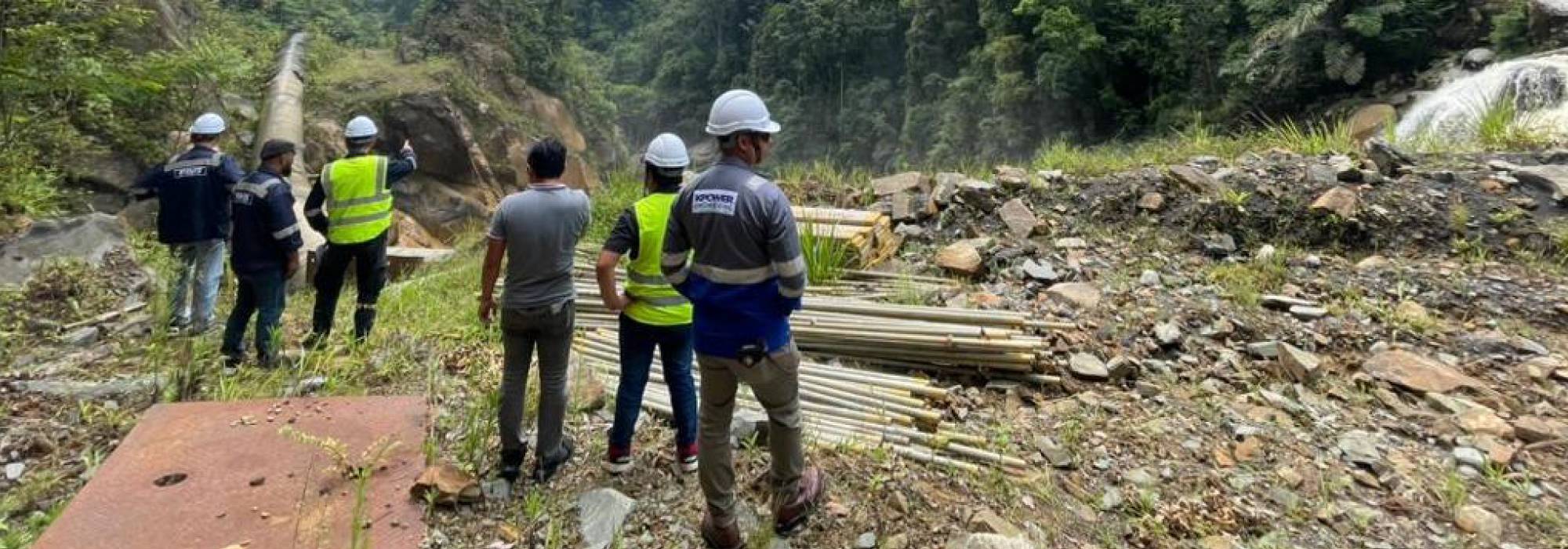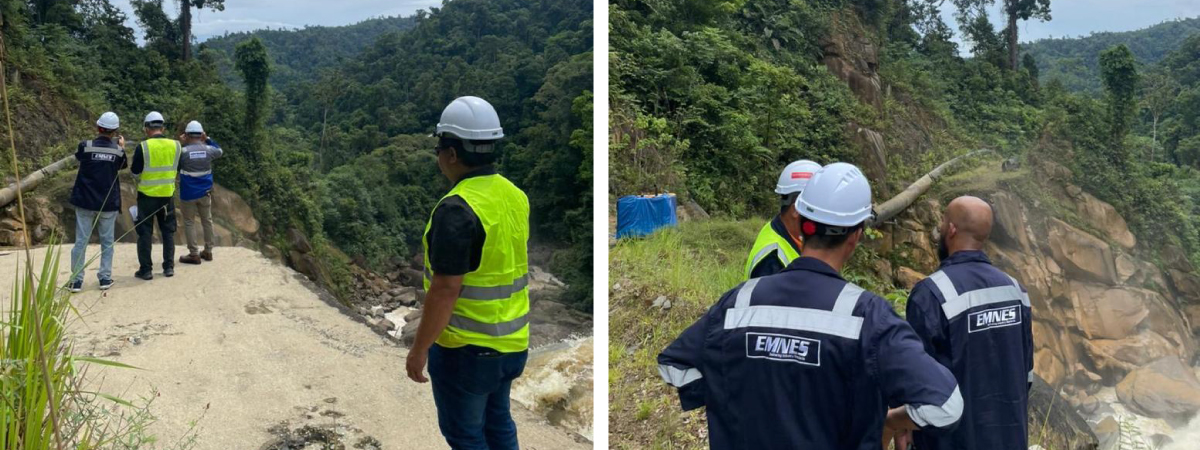
Renewable Energy – Small Hydro Power Plants
A Smart Way of Solving Environmental and Economic Challenges
The global climate change calls for new and more ecofriendly methods of power generation. At the same time, each power plant investment must pay itself off within a certain period of time. Using the enormous power of water – one of mankind’s oldest ideas for power conversion – can combine both ecofriendly and economic power generation.
EMNES ensures that its small hydropower plants preserve the ecosystem by ensuring the construction work complies with the local and international legal frame to protect the lives and livelihood of our rainforest.
EMNES’s small hydro expertise ranges from engineering, supply, procurement, installation and commissioning to service. We are the reliable partner for integrated and customized small hydro turnkey solutions.

What EMNES can offer:
Polyethylene, chosen primarily for its chemical stability, provides maximum protection against both chemical and electrolytic corrosion and offers excellent resistance to abrasion, shrinkage, cold, heat, pressure, bending and stretching.
Water to wire solutions for small hydro power plants represent a holistic approach to the generation of electricity through hydropower. This comprehensive system encompasses the entire process, commencing with the intake of water from a natural source, directing it through a penstock to create hydraulic pressure, utilizing a hydraulic turbine to harness this pressure to turn a generator, and ultimately converting the mechanical energy into electrical power.
The generated electricity is then channeled into a well-integrated electrical system that includes transformers and controls, enabling it to be seamlessly integrated into either a localized distribution network or a broader power grid. This approach embodies an environmentally sustainable and efficient means of electricity generation, leveraging the natural kinetic energy of flowing water to produce clean and renewable power
Modernization and service of existing plants with minimized production losses is a strategic approach aimed at enhancing the operational efficiency, reliability, and longevity of established industrial facilities while mitigating disruptions to ongoing production processes. This process typically involves the assessment and upgrade of aging or outdated equipment, automation systems, and infrastructure within the plant.
The objective is to optimize the plant’s performance, reduce downtime, and improve its environmental and safety compliance, all while minimizing the impact on the ongoing production output. By employing cutting-edge technologies, retrofitting equipment, and conducting preventative maintenance, industries can not only extend the useful life of their assets but also boost productivity, reduce energy consumption, and ensure that their operations remain competitive and sustainable in the long term
Local support, maintenance, and service for the highest availability entail the provision of comprehensive, on-the-ground assistance and upkeep to ensure the continuous and reliable operation of complex systems or equipment. This approach involves establishing a localized support network that offers immediate access to technical expertise, spare parts, and maintenance services. The primary goal is to maximize the uptime and availability of critical machinery or systems, reducing the risk of costly downtime.
By maintaining a local presence, organizations can respond swiftly to issues, conduct routine maintenance, and implement system improvements as necessary, ultimately safeguarding the smooth and uninterrupted operation of their assets. This strategy is particularly crucial for industries where downtime can lead to significant production losses, safety concerns, or service disruptions, ensuring that systems are continually optimized and performing at their peak.
Ensuring the highest degree of operational safety and efficiency, even for the smallest plants, involves implementing rigorous practices and technology solutions to create a secure and optimized operational environment. This approach recognizes that the size of a facility does not diminish the importance of safety and efficiency. It encompasses the deployment of advanced safety protocols, maintenance routines, and process optimization techniques to mitigate risks, reduce accidents, and maximize productivity.
Small plants, like their larger counterparts, benefit from measures such as predictive maintenance, real-time monitoring, and automation to enhance operational reliability and efficiency. By prioritizing safety and efficiency at every scale, organizations can maintain a competitive edge, minimize operational disruptions, and meet regulatory and environmental standards, ensuring the long-term sustainability of their operations.
Renewable Energy – Small Hydro Power Plants
A Smart Way of Solving Environmental and Economic Challenges
The global climate change calls for new and more ecofriendly methods of power generation. At the same time, each power plant investment must pay itself off within a certain period of time. Using the enormous power of water – one of mankind’s oldest ideas for power conversion – can combine both ecofriendly and economic power generation.
EMNES ensures that its small hydropower plants preserve the ecosystem by ensuring the construction work complies with the local and international legal frame to protect the lives and livelihood of our rainforest.
EMNES’s small hydro expertise ranges from engineering, supply, procurement, installation and commissioning to service. We are the reliable partner for integrated and customized small hydro turnkey solutions.

What EMNES can offer:
Polyethylene, chosen primarily for its chemical stability, provides maximum protection against both chemical and electrolytic corrosion and offers excellent resistance to abrasion, shrinkage, cold, heat, pressure, bending and stretching.
Water to wire solutions for small hydro power plants represent a holistic approach to the generation of electricity through hydropower. This comprehensive system encompasses the entire process, commencing with the intake of water from a natural source, directing it through a penstock to create hydraulic pressure, utilizing a hydraulic turbine to harness this pressure to turn a generator, and ultimately converting the mechanical energy into electrical power.
The generated electricity is then channeled into a well-integrated electrical system that includes transformers and controls, enabling it to be seamlessly integrated into either a localized distribution network or a broader power grid. This approach embodies an environmentally sustainable and efficient means of electricity generation, leveraging the natural kinetic energy of flowing water to produce clean and renewable power
Modernization and service of existing plants with minimized production losses is a strategic approach aimed at enhancing the operational efficiency, reliability, and longevity of established industrial facilities while mitigating disruptions to ongoing production processes. This process typically involves the assessment and upgrade of aging or outdated equipment, automation systems, and infrastructure within the plant.
The objective is to optimize the plant’s performance, reduce downtime, and improve its environmental and safety compliance, all while minimizing the impact on the ongoing production output. By employing cutting-edge technologies, retrofitting equipment, and conducting preventative maintenance, industries can not only extend the useful life of their assets but also boost productivity, reduce energy consumption, and ensure that their operations remain competitive and sustainable in the long term
Local support, maintenance, and service for the highest availability entail the provision of comprehensive, on-the-ground assistance and upkeep to ensure the continuous and reliable operation of complex systems or equipment. This approach involves establishing a localized support network that offers immediate access to technical expertise, spare parts, and maintenance services. The primary goal is to maximize the uptime and availability of critical machinery or systems, reducing the risk of costly downtime.
By maintaining a local presence, organizations can respond swiftly to issues, conduct routine maintenance, and implement system improvements as necessary, ultimately safeguarding the smooth and uninterrupted operation of their assets. This strategy is particularly crucial for industries where downtime can lead to significant production losses, safety concerns, or service disruptions, ensuring that systems are continually optimized and performing at their peak.
Ensuring the highest degree of operational safety and efficiency, even for the smallest plants, involves implementing rigorous practices and technology solutions to create a secure and optimized operational environment. This approach recognizes that the size of a facility does not diminish the importance of safety and efficiency. It encompasses the deployment of advanced safety protocols, maintenance routines, and process optimization techniques to mitigate risks, reduce accidents, and maximize productivity.
Small plants, like their larger counterparts, benefit from measures such as predictive maintenance, real-time monitoring, and automation to enhance operational reliability and efficiency. By prioritizing safety and efficiency at every scale, organizations can maintain a competitive edge, minimize operational disruptions, and meet regulatory and environmental standards, ensuring the long-term sustainability of their operations.
